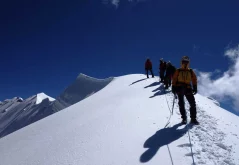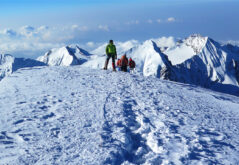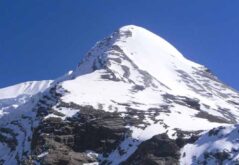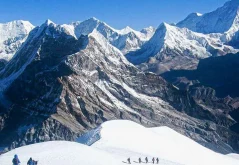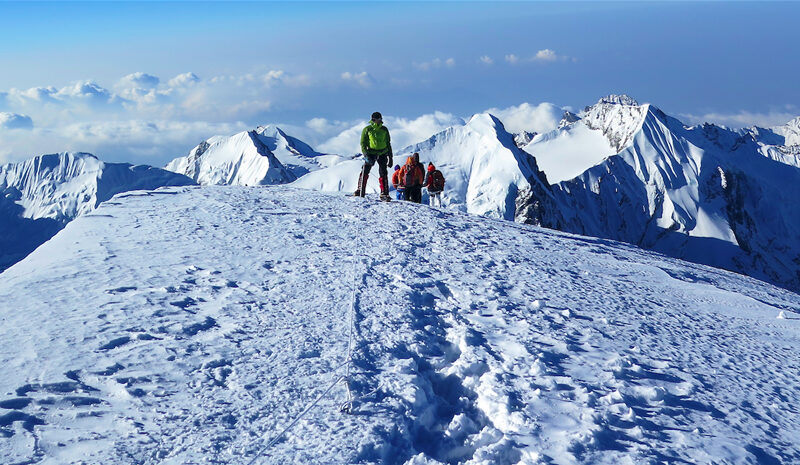
Pisang Peak Climbing
TripOverview
Pisang Peak locally known as Jong Ri is located in the Northern Part of Nepal. Similarly, Pisang Peak lies in the Manang district between Annapurna I and Manaslu. It stands tall with a height of 6091m. Likewise, Pisang Peak is the most famous peak climbing in Nepal. The main reason for Pisang Peak’s popularity is the ease of the route. Pisang Peak starts from Yak Pastures above the village of Pisang on a uniform slope to the final summit pyramid. Similarly, the pyramid at the peak is made up of snow and ice slope. Most importantly, the first recorded success to Pisang Peak was in 1955 AD by a German Expedition group. And, from that day onwards the popularity of Pisang Peak kept growing. Likewise, from that year onwards a lot of passionate climbers and trekkers did the Pisang Peak Climbing. Up to this day, the number of successful ascend to the Pisang Peak is increasing day by day.
Important Article: How to Handle Altitude sickness while climbing in Nepal
Although Pisang Peak is an easy climb it requires climbers to be physically fit. Being mentally tough is equally important as being physically fit. So, you should do this climb with peace of mind. Considered easy peak climbing, Pisang Peak provides its climbers with an interesting and entertaining journey. During the trip to Pisang Peak, you will get a chance to explore various ecosystems, diverse climates, weather, and amazing landscapes. In addition, it gives you a chance to experience the diverse cultures of the place. Lastly, climbing at high altitudes is always challenging. Similarly, while climbing to Pisang Peak you will get a picture-perfect view of the Himalayas. So, a high level of physical fitness and health is highly recommended for Pisang Peak Climbing.
Who can do Pisang Peak Climbing?
If you are a climbing lover and love to travel at high altitudes then this climb is excellent for you. In addition, Pisang Peak does not require special training and experience to do it. Almost anyone ardent and fit enough to do it can finish this trek and climb very comfortably. If you are an adventurous person then Pisang Peak Climbing is a perfect adventure for you. It gives you plenty of adventurous experiences during the climb. Likewise, when you do this climb you will feel a sense of adrenaline rush throughout your body. Pisang Peak is not that challenging and hard. So, if you are thinking and planning to go on a bigger expedition like Everest and Lhotse then This peak is perfect training for you.
Why do this Pisang Peak Climbing?
There are several reasons for one to do the Pisang Peak. But, the most popular reason to do the Pisang Peak is it provides you with the ultimate climbing experience of Nepal. Similarly, it gives you an unforgettable view of the giant mountains like Annapurna and Dhaulagiri. Likewise, you will get a once-in-a-lifetime chance to experience the nature of the abundant flora and fauna of the place. In addition, when you are on the trail of Pisang Peak Climbing you can observe different kinds of cultures and enjoy the journey. Therefore, if you love climbing and are passionate about climbing at high altitudes then It is perfect for you.
Highlights
- Get magnificent views of the Himalayas.
- Explore unforgettable views of Annapurna and Dhaulagiri.
- Experience abundant flora and fauna.
- Experience a different culture.
- Observe unique mountain flights.
- Get a spectacular & challenging Himalayan climb.
- Learn moderate technical climbing.
- Safety by qualification experience quality
- Explore a well-designed approach for appropriate acclimatization.
- Chance to travel with trained Sherpa climbing guides
TripItinerary
Arrival at Kathmandu airport and Transfer to Hotel
Today you will arrive at the Tribhuvan International Airport and your arrival representative will transfer you to the requested hotel.
Preparation for the trip
After spending time in the comfortable hotel today, you will do the necessary preparation for the journey. You can even visit the world heritage sites of Kathmandu if you have free time after your preparation. There you will know the history of ancient Nepali civilization and cultures.
Drive from Kathmandu to Besisahar (823m/2,700ft, 08hrs)
On day three of our journey at Pisang Peak Climbing today we will drive from Kathmandu to Besisahar at an altitude of 823m. There you will get to see different flora and fauna including some lush forest. Similarly, after you reach Besisahar you will get to visit the Besisahar and know about the locals and their culture. In addition, after you reach Besisahar which is an 8 hours drive from Kathmandu you will rest at a comfortable lodge for the day.
Drive from Besisahar to Dharapani (1860m/6,103ft, 06hrs)
Similar to day 3 we will continue our driving journey from Besisahar to Dharapani. Likewise, you will be at an altitude of 1860m when driving from Besisahar to Dharapani. Furthermore, when you are driving from Besisahar to Dharapani you will see various ecosystems of Nepal. You will even see different domesticated animals during your journey. After you reach a certain height then you can see the charm of the place with your own eyes. Similarly, you can also enjoy the climate of the place. Lastly, after you reach Dharapani you will rest at a relaxing lodge for the night.
:Trek from Dharapani to Chame (2670m/9,055ft, 05-06hrs)
Today is the first day of your trekking journey. Similarly, today we will trek from Dharapani to Chame at an altitude of 2670m. Likewise, the trek from Dharapani to Chame takes about 5-6 six hours, so, you should not hurry and take your time enjoying the surroundings of the place. The trails from Dharapani to Chame are slightly steep so you have to walk very carefully at your own pace or you might injure yourself. In addition, after we reach Chame we will lay down at a relaxing lodge accommodation.
Treks from Chame to Upper Pisang (3100m/10170ft, 05 hrs)
After a light breakfast at Chame, we will continue our trek ascending from Chame. The trails of Chame can be a little challenging for the rookie trekkers. So, make sure you do it at your own pace. Furthermore, this trek is at a high altitude so make sure you hydrate yourself during the trek. In addition, this is a 5 hours long trek so we will stop at a suitable lodge or tea house for your lunch. After that, we ascend towards Upper Pisang and rest there at a comfortable lodge and enjoy their hospitality.
Rest and acclimatization at Upper Pisang before the climb up to Base camp.
Today is the rest and acclimatization day at Upper Pisang before the climb to the Base Camp. there you will be familiar with the environment which is very important for you for your further journey.
Trek from Pisang to Pisang peak Base Camp (4573m/15000, 05hrs)
Today is an exciting day for you at your Pisang Peak climbing because today you will trek from Upper Pisang to Pisang Peak Base Camp. Similarly, this trek is done at a very high altitude of 4573m and for almost 5 hours. But, you should not hurry in excitement. In addition, after we reach the base camp we will see a picture-perfect view of Pisang Peak. After enjoying the views from the base camp we will find a suitable resting place and set our camp there.
Trek from Pisang base camp to high camp (5030m/16498ft, 06hrs)
Today we will trek from the base camp to high camp ascending through some of the snowy peaks. Similarly, the snowy peaks are very beautiful, making you forget all your pains. Lastly, after we reach the high camp we will be camping and resting for the night.
Day for acclimatization at high centers; (6091m/19978ft)
On day 10th of your Pisang Peak Climbing, you will acclimatize at the high centers. Similarly, today as per your physical fitness and weather condition. If you feel comfortable, you may attempt the summit push. Likewise, if you attempt the summit you will be at the height of 6091m. From where you will get a beautiful view of the surroundings.
Additional day for summit push (6091m/19978ft, 07hrs/)
Today is an additional day for the summit push for those of you who didn’t attempt the summit on day 10th. if the previous day was not suitable due to weather or physical condition. Similarly, after summiting and stepping into the pinnacle of the world we will return to the base camp and rest for the night. Overnight at camp.
Trek from Pisang peak base camp to Manang (3540m/11611ft, 02hrs)
Today we will trek from Pisang Base Camp to Manang. We will descend from Pisang Peak Base Camp to Manang at an altitude of 3540m. Furthermore, this trek is shorter than the other trekking journey. In addition, after we reach Manang which is very famous for its beautiful sceneries we will rest at a comforting lodge for the night and have local cuisine for dinner.
Trek from Manang to Yak Kharka (4350m/14,272ft, 04hrs)
Today we will descend from Manang to Yak Kharka at an altitude of 4350m, during the trek from Manang to Yak Kharka we will see different flora and fauna of the place. Similarly, you can capture the beautiful movements of your trip. In addition, this trek is 4 hours long so you will have more time to have fun during the trek. Overnight at lodge.
Trek from Yak Kharka to Thorong Phedi (4420m/14,501ft, 05hrs)
On day 14 of our trek from Yak Kharka to Thorong Phedi at an altitude of 4420m. Similarly, after you reach Thorong Phedi we will rest at a lodge for the nightstand and have tasty cuisine as dinner in the lodge.
Trek from Thorong Phedi to Muktinath (3850m/12,631ft, 09hrs)
After breakfast at Thorong Phedi, we descend to Muktinath at an altitude of 3850m. Similarly, we will do this trek via the famous Thorong La Pass. Muktinath has a great value for Nepali People a lot of people come to Muktinath to worship gods and to have pure souls. At Muktinath, we will rest in a comfortable lodge and enjoy the view of the surrounding area.
Trek from Muktinath to Jomsom (2700m/8,858ft, 04hrs)
On day 16 of our Pisang Peak Climbing, we will descend from Muktinath to Jomsom at an altitude of 2700m. Similarly, this trek takes 4 hours. Furthermore, after we reach Jomsom we will rest at a cozy lodge for the night.
Flight from Jomsom to Pokhara (950M/3,116ft). Transfer to hotel
Today we will fly from Jomsom to Pokhara and enjoy a scenic flight. Furthermore, after you reach Pokhara we will be there to welcome you to a comfortable lodge.
Drive from Pokhara to Kathmandu.
Today is the last day so you will drive from Pokhara to Kathmandu by tourist bus that takes about seven hours, you can also take a flight that takes about 25 minutes. After you reach Pokhara you will rest at a beautiful lodge. Where they will provide a farewell dinner with a cultural program in the evening.
After having breakfast, Drop at the airport for final departure
Today is the final day of your journey. So, after breakfast, you will be dropped at the airport for your final departure.
IncludedExcluded
Whats Included
- Arrival & Departure: Airport - Hotel transfers – Airport (Pick Up and Drop).
- Hotel Accommodation in Kathmandu: 3 nights hotel in Kathmandu (3 Star Category) on bed & breakfast Basis- Sharing Twin Bed Room.
- Welcome Dinner: One Welcome Dinner in a tourist standard restaurant in Kathmandu with Office’s Staff.
- Permit All necessary paperwork: Pisang Peak Climbing climbing Permit from NMA, Garbage Management: Garbage Deposit fees.
- Insurance: Medical & Emergency rescue Insurance for all involved Nepalese staff during the trek and climbing.
- Map: Trekking and climbing map.
- Air Transportation: (Domestic Flight) Fly from Kathmandu – Pokhara and while returning Pokhara - Kathmandu, as per itinerary.
- Climbing Stuffs Transportation: Necessary all equipment Transportation for all Members and Staffs from Kathmandu to Pokhara (by air cargo) and to Base camp (by Porters)– While returning: Base camp to Pokhara (by porters) and Pokhara to Kathmandu (by air cargo).
- Member Luggage: Up to 25 Kg per member for personal baggage during the trek carrying by porters.
- Food and Lodging: 3 Food 3 meals a day (BDL; including tea and coffee) along with accessible accommodation at Hotel/Lodge during the trek.
- Drinking: 2 liters of boiled water to carry on thermos per day per member.
- Porter: Porters (1 member: 1 Porter) during the trek.
- Climbing Sherpa: Veteran and Government Licensed Climbing Guide.
- Climbing Sherpa Salary & Allowance: Climbing Sherpa Salary, Equipment, Food, and Clothing.
- Staff Salary and allowance: All Nepalese staff & porters daily wages, salary, equipment, foods & clothing
- Oxygen Bottle (O2): Oxygen bottles will be in stock at base camp in case of an emergency (with appropriate charge).
- High camp service: Necessary cooking gas, cooking pot for members, high altitude tent (sharing basis), high food for members, Sherpa, and climbing crews. Group climbing gears, fixed and dynamic rope during the climbing period as required.
- Light: Necessary light at all tents. * if required.
- Guide: Government licensed Guide (English speaking) during the trek and sight-seeing in Kathmandu valley.
- Valley Sightseeing: Sightseeing in Kathmandu Valley [Swoyambhu (Monkey Temple) and Kathmandu Durbar Square] by a professional guide.
- Comprehensive Medical kit.
- Certificate: Pisang Peak Climbing climbing certificate issued by Nepal Mountaineering Association (after climbing the Pisang Peak Climbing successfully).
Whats Excluded
- Air Fare: International flight airfare (from and to Kathmandu).
- Nepal entry Visa fee: Nepali Visa fee is USD 60 per person for 30 days and to be applied for 60 days is USD 120.
- Lunch & Dinner: Lunch & dinner during the stay in Kathmandu (also in case of early return from Trekking / Expedition than the scheduled itinerary).
- Extra night in Kathmandu: Extra nights’ accommodation in Kathmandu. In case of early arrival or late departure, early return from Trekking / Expedition (due to any reason) than the scheduled itinerary.
- Insurance: Travel and high altitude insurance, accident, helicopter medical & emergency evacuation. *Mandatory
- Rescue Evacuation: Medical and emergency rescue evacuation costs if required. (Rescue, Repatriation, Helicopter, Medication, Medical Tests and Hospitalization costs.)
- Personal Expenses: Telephone, Internet, Toiletries, battery recharge, hot shower, laundry, any Alcoholic beverages (during the trek and in Kathmandu but we will serve soft drinks for members in base camp).
- Personal Equipment: Clothing, Packing Items or Bags, Personal Medical Kit, Personal Trekking /Climbing Gears.
- Toiletries: Soaps, shampoos, toilet and tissue papers, toothpaste, and other items used to keep yourself clean.
- Filming: Special Filming, Camera, and Drone permit fee.
- Internet Service: Not included during the trek.
- USD 25 for an extra porter per day (If extra porter demanded).
- Summit Bonus: Summit bonus for climbing Sherpa.
- Tips: Tips for Basecamp and other staff.
- Extra: Any other services or activities, which are not mentioned in the itinerary.
- Any other item not listed in the “Cost Includes” section.
UsefulInfo
Best time to do Pisang Peak Climbing
The best time to do Pisang Peak Climbing is during the spring and autumn seasons. At this time of the year, you will have perfect weather and climate for the climb. Similarly, you will find suitable porters and guides as well. At this time of the year, you will get to travel to Pisang Himal in clear visibility with a clear view of the surrounding area. Pisang Peak is a perfect holiday destination for you so you can enjoy your holiday with your friends and family. Similarly, if you come here at this time of the year then it can double your fun with your friends and family. If you want to fully explore and enjoy the beauty of Pisang Peak then this time of the year is very suitable. However, Pisang Peak Climbing can also be done in the monsoon season. This time of the year also provides you with the perfect weather and climate. But, many trekkers and climbers prefer to do Pisang Peak Climbing in the autumn and spring season because this time of the year is the festive season in Nepal. So, they will get to observe and explore the culture of Nepal at the same time as they climb Pisang Peak.
The difficulty of Pisang Peak Climbing
Pisang Peak is not that difficult to climb; almost anyone over 18 years of age can do it. But, there are some things that you should consider before and while climbing Pisang Peak. Similarly, you should book guides and accommodation before your journey. You should console your trekking and climbing company ahead of your journey. So that they can do the preparation accordingly and you will not have any problem booking guides and accommodation on your trip. The other difficulty that you are going to face when you are climbing at the Pisang Peak is the lack of proper accommodation and porters facility if you travel here during the on seasons. Similarly, if you travel here during the on seasons then the weather and temperature can also affect your visit to Pisang Peak. But, the most common challenge you are going to face at Pisang Peak is altitude sickness. Therefore, to not fall victim to altitude sickness you are required to drink enough water and you should acclimatize yourself properly.
Meals and accommodation at Pisang Peak Climbing
While climbing to the high altitudes your meals must be at the point. Similarly, your accommodation is equally important as your meals because without proper accommodation you cannot complete your journey. So, we at Peak Climbing In Nepal try to provide the best facility to our visitors. We provide them with the proper hotels, lodges, and tea houses to rest. Similarly, when we reach our climbing period then we provide a suitable camping facility and environment to rest. Likewise, when it comes to meals we provide both Nepali and Western foods. However, western foods are slightly more expensive than Nepali foods. The reason for this is that Nepali foods are produced using local ingredients and spices. Whereas western foods are mostly imported from the cities. Similarly, the higher you go up in altitude the more expensive food and accommodation facilities get.
Climate and weather at Pisang peak Climbing
The climate and weather of the Himalayas are very incalculable. It can change without a hint and sign. Therefore, climbers should be very careful during Pisang Peak Climbing. So, climbers must be very careful planning their trip to Pisang Peak. Furthermore, this climb is a multi-day trip, so the chances for trekkers to face adverse weather at base camp are always high. Likewise, the temperature in the Himalayan region is mostly below 0. Therefore, make sure you carry warm clothes with you during the trip. Regarding the condition, the ideal season to do Pisang Peak Climbing is during the autumn and spring seasons. During this time you will climb in a pleasant climate which can help you climb quickly and effectively.
Safety and security at Pisang Peak Climbing
You should not worry about your safety and security when you are with us. We understand that climbing at the high altitudes of Nepal is always dangerous due to the harsh climate from time to time and steep roads. Therefore the safety and security of our visitors is always a top priority for us. We fully take care of our consumers and their belongings when they are with us. Similarly, the accommodation facilities we provide are also safe and secure.
Fitness and experience requirement for Pisang Peak Climbing
Pisang Peak Climbing is one of the physically challenging climbs in Nepal. Even some of the most experienced trekkers and climbers find it hard sometimes to travel through these trials of Pisang Peak. So, you have little knowledge of this climb successfully. Similarly, you have to be physically fit for this trek and climb. If you have some health issues, then it will be next to impossible for you to travel or complete this trek. In addition, make sure that you do a full body checkup before heading toward the trek. In addition, walking and jogging, and running before Pisang Peak Climbing are very beneficial.
Frequently AskedQuestions
When is the best time for the Pisang Peak Climbing?
Autumn (September, October, November) and spring (March, April, May) are suitable for Pisang Peak Climbing. However, it is possible in monsoon seasons too.
How difficult is the Pisang Peak Climbing?
How much will it cost to climb Pisang Peak Climbing?
Can you climb the Pisang Peak Climbing alone?
Do I need a climbing permit for the Pisang Peak Climbing?
Can you have altitude sickness on the Pisang Peak Climbing?
What is the food price at Pisang Peak Climbing?
How many hours do I need to walk per day?
Can I carry children to Pisang Peak Climbing?
Is the Pisang Peak Climbing trail crowded?
What will happen If I get sick during the Pisang Peak Climbing?
Is charging my phones and batteries possible during the route of the Pisang Peak Climbing?
Can children do Pisang Peak Climbing?
Can I do Pisang Peak Climbing With friends?
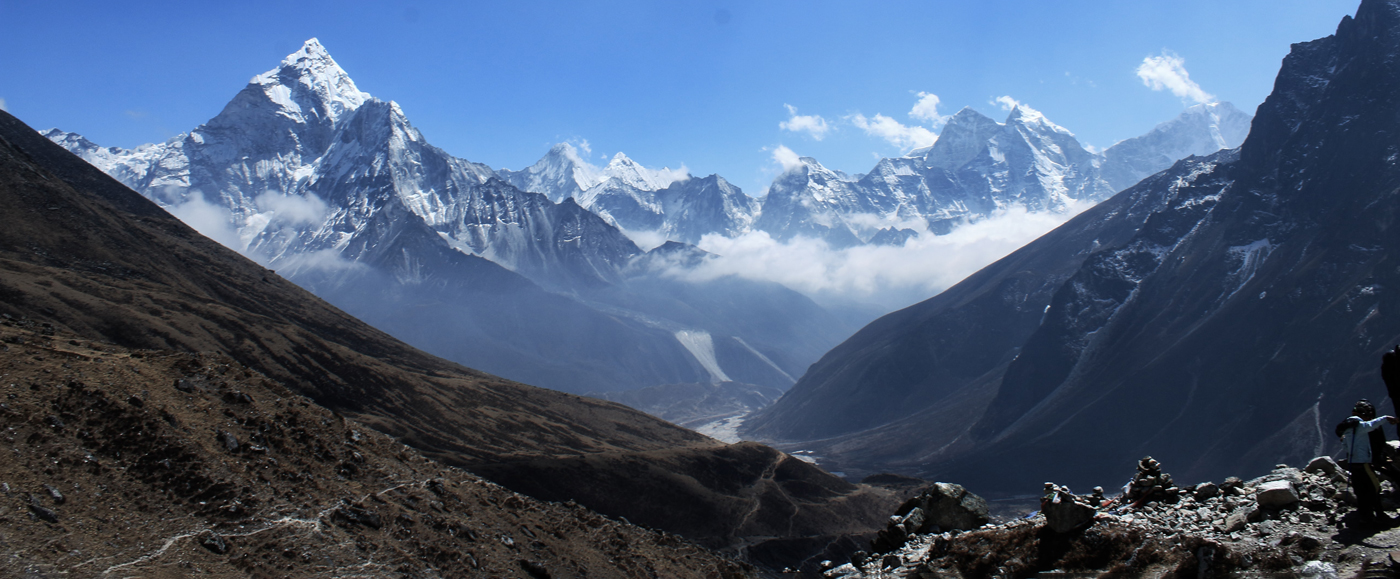
Need Assistance
Need Help? Call us or drop a message. Our agent will be in touch shortly.

